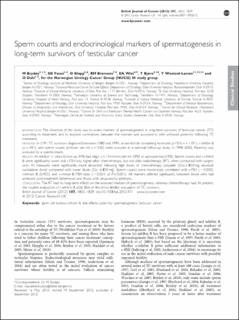| dc.contributor.author | Brydøy, Marianne | |
| dc.contributor.author | Fosså, Sophie Dorothea | |
| dc.contributor.author | Klepp, Olbjørn | |
| dc.contributor.author | Bremnes, Roy M. | |
| dc.contributor.author | Wist, Erik | |
| dc.contributor.author | Bjøro, Trine | |
| dc.contributor.author | Wentzel-Larsen, Tore | |
| dc.contributor.author | Dahl, Olav | |
| dc.date.accessioned | 2022-05-10T14:12:04Z | |
| dc.date.available | 2022-05-10T14:12:04Z | |
| dc.date.created | 2012-12-05T11:32:33Z | |
| dc.date.issued | 2012 | |
| dc.identifier.citation | British Journal of Cancer. 2012, 107 (11), 1833-1839. | en_US |
| dc.identifier.issn | 0007-0920 | |
| dc.identifier.uri | https://hdl.handle.net/11250/2995123 | |
| dc.description.abstract | Background:
The objective of this study was to assess markers of spermatogenesis in long-term survivors of testicular cancer (TC) according to treatment, and to explore correlations between the markers and associations with achieved paternity following TC treatment.
Methods:
In 1191 TC survivors diagnosed between 1980 and 1994, serum-follicle stimulating hormone (s-FSH; n=1191), s-inhibin B (n=441), and sperm counts (millions per ml; n=342) were analysed in a national follow-up study in 1998–2002. Paternity was assessed by a questionnaire.
Results:
At median 11 years follow-up, 44% had oligo- (<15 millions per ml; 29%) or azoospermia (15%). Sperm counts and s-inhibin B were significantly lower and s-FSH was higher after chemotherapy, but not after radiotherapy (RT), when compared with surgery only. All measures were significantly more abnormal following high doses of chemotherapy (cisplatin (Cis)>850 mg, absolute cumulative dose) compared with lower doses (Cis ⩽850 mg). Sperm counts were moderately correlated with s-FSH (−0.500), s-inhibin B (0.455), and s-inhibin B : FSH ratio (−0.524; all P<0.001). All markers differed significantly between those who had achieved post-treatment fatherhood and those with unsuccessful attempts.
Conclusion:
The RT had no long-term effects on the assessed markers of spermatogenesis, whereas chemotherapy had. At present, the routine evaluation of s-inhibin B adds little in the initial fertility evaluation of TC survivors. | en_US |
| dc.language.iso | eng | en_US |
| dc.publisher | Springer Nature | en_US |
| dc.rights | Navngivelse-Ikkekommersiell-DelPåSammeVilkår 4.0 Internasjonal | * |
| dc.rights.uri | http://creativecommons.org/licenses/by-nc-sa/4.0/deed.no | * |
| dc.title | Sperm counts and endocrinological markers of spermatogenesis in long-term survivors of testicular cancer | en_US |
| dc.title.alternative | Sperm counts and endocrinological markers of spermatogenesis in long-term survivors of testicular cancer | en_US |
| dc.type | Peer reviewed | en_US |
| dc.type | Journal article | en_US |
| dc.description.version | publishedVersion | en_US |
| dc.subject.nsi | VDP::Onkologi: 762 | en_US |
| dc.subject.nsi | VDP::Oncology: 762 | en_US |
| dc.source.pagenumber | 1833-1839 | en_US |
| dc.source.volume | 107 | en_US |
| dc.source.journal | British Journal of Cancer | en_US |
| dc.source.issue | 11 | en_US |
| dc.identifier.doi | 10.1038/bjc.2012.471 | |
| dc.identifier.cristin | 968307 | |
| cristin.ispublished | true | |
| cristin.fulltext | original | |
| cristin.qualitycode | 2 | |

